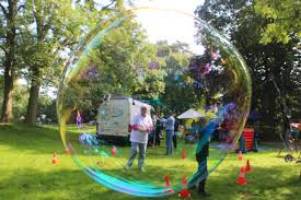Summary
This lesson engages students in the concept of rounding numbers. Students participate in a hands-on exploration that allows them to visualize and master the concept.
Essential Question(s)
Why do we round numbers?
Snapshot
Engage
Students attempt to answer an example problem that uses rounding.
Explore
Students use a clothesline to visualize the concept of rounding.
Explain
Students create a chant, song, or rap to help them know why and how to round numbers.
Extend
Students solve and create real-world problems that use rounding.
Evaluate
Students revise their answers from the Engage.
Materials
Sticky notes
String
Clothespins
Notecards
Markers
Student number lines
Engage
Present students with the following scenario:
Shantay’s family is having a family reunion next weekend. There will be 37 people at the reunion. Shantay and her mom need to bring plates to the event, but they only come in packs of 10. How many plates will they have to buy for the meal?
Ask students to think about how many plates they should buy and write their answer on a sticky note. Select a few different students to explain their thinking.
Have students put the sticky note at the corner of their desk. You will come back to the problem.
Explore
Hang a string between two points in your classroom. This string will represent a number line.
Ask students, “When counting by 10s, which number comes before 37?” Mark 30 on the clothesline by hanging a "30" notecard on the string using a clothespin.
Ask students, “What 10s number comes after 37?” Mark 40 on the clothesline by hanging a "40" notecard (to the right of 30 but with space in between) on the string using a clothespin.
Ask students to tell you where they think 37 should be on the line. Place a notecard at the point where 37 would be.
Ask students, “Which number, 30 or 40, is 37 closer to?” Students should respond, "40."
Have students use the Elbow Partner strategy for working in partner pairs. Ask the pairs to use a number line to think about repeating the above task with different numbers. Have them try the following:
46 to the nearest 10; 82 to the nearest 10; 21 to the nearest 10; 3 to the nearest 10; 75 to the nearest 10.
Ask students to think about what it might look like to round numbers to the nearest hundred. Have them try the following:
337 to the nearest 100; 989 to the nearest 100; 655 to the nearest 100
In partners, have students review the answers. Ask students, “What patterns do you notice?” When describing their answers, ask students to be specific in talking about the place value."
Explain
In partners, have students develop a definition of “rounding” numbers.
As a class, have students share ideas to build a class definition.
If the class hasn’t figured it out, explain what to do when rounding with 5s.
Using the Chant It, Sing It, Rap It strategy, have students create a chant/dance to help them remember why and how to round numbers.
Ask the class, "What are some situations where we might want to round numbers?"
Extend
Using the Think-Pair-Share strategy, have students solve the following problem and share their ideas.
Mr. Brown is buying snacks for his class of 22 students. The snacks come in either boxes of 12 or 30. Which box should he buy? How many boxes? Why do you think that is the best option?
Then have students create their own problems using the Think-Pair-Share strategy. In pairs, have students create a problem that would involve rounding. Then partner with another set of partners (now groups of four) to solve the problem.
Evaluate
On the sticky note from the Engage, have students add to or revise their answers based on what they learned from the lesson. When they are finished, have them place the revised sticky note on the board.
Resources
K20 Center. (n.d.). Chant it, sing it, rap it. Strategies. https://learn.k20center.ou.edu/strategy/143
K20 Center. (n.d.). Elbow partners. Strategies. https://learn.k20center.ou.edu/strategy/116
K20 Center. (n.d.). Think-Pair-Share. Strategies. https://learn.k20center.ou.edu/strategy/139


